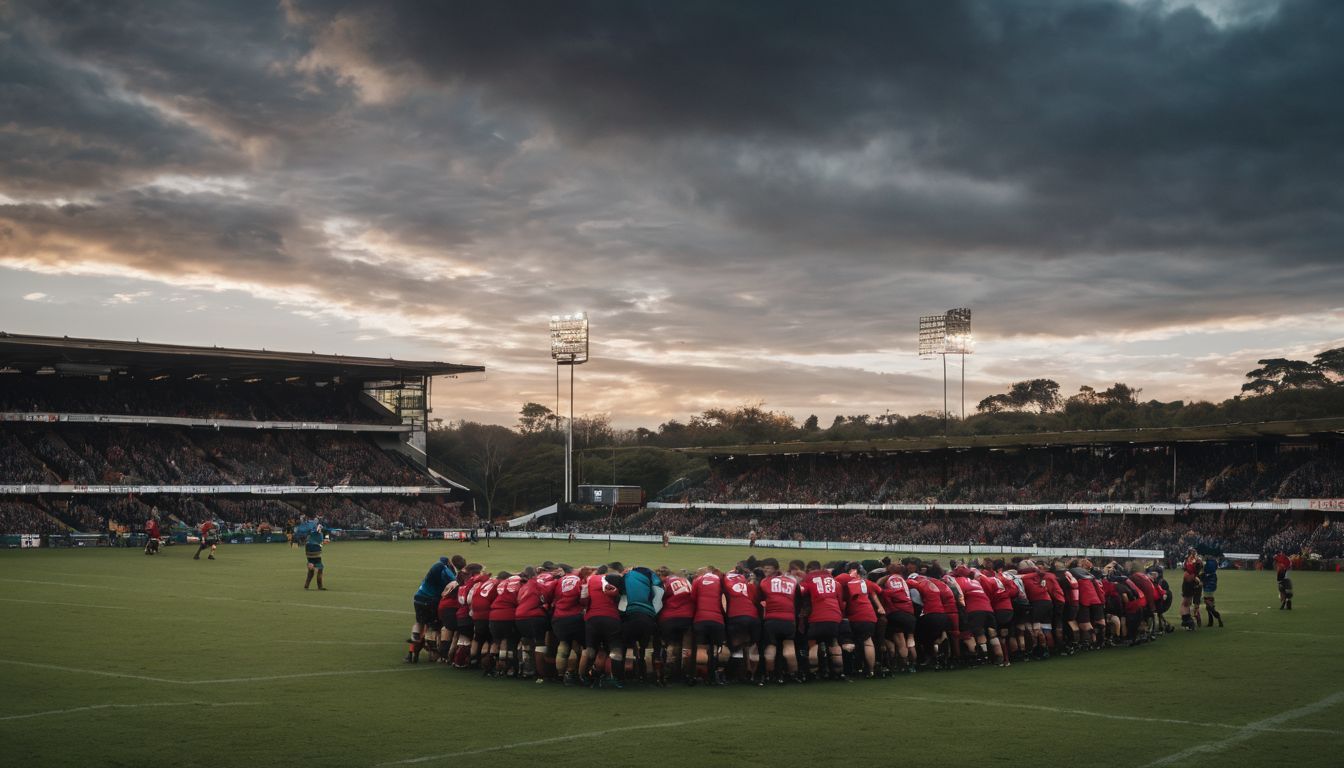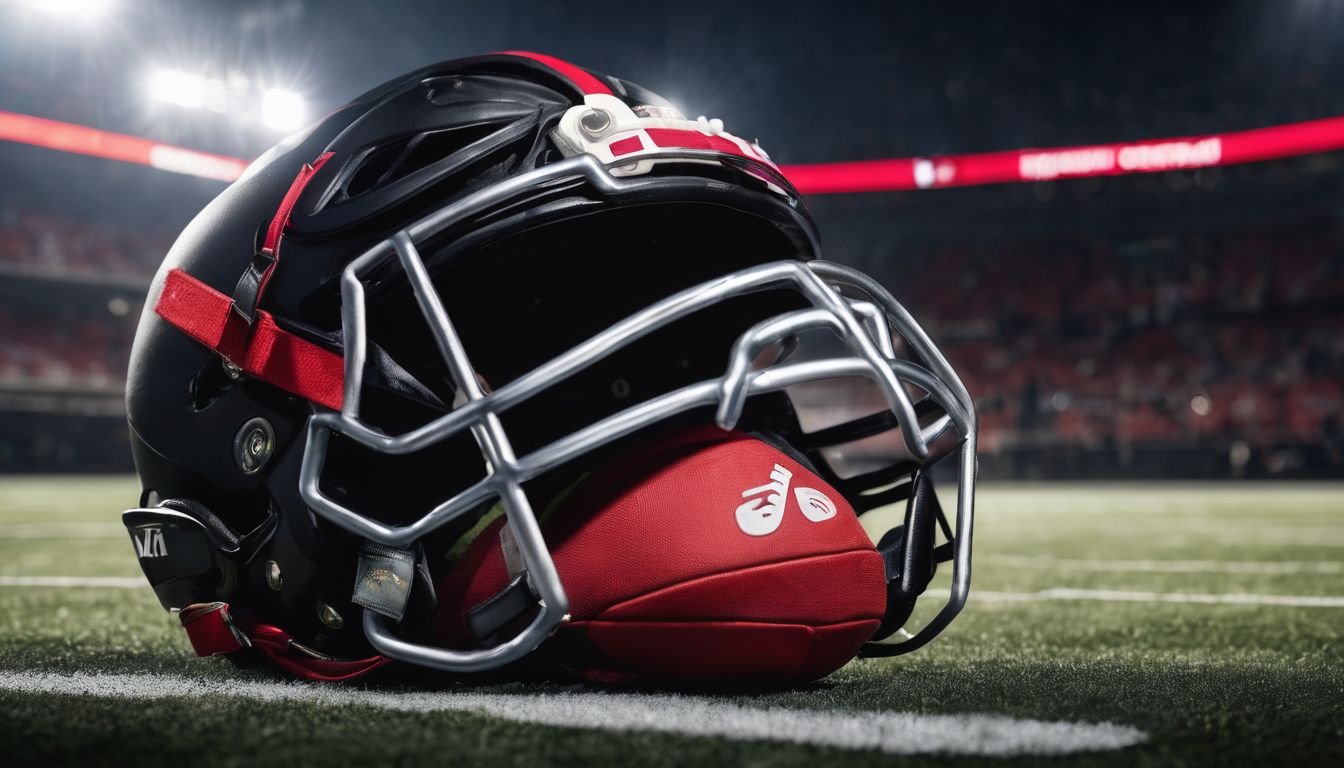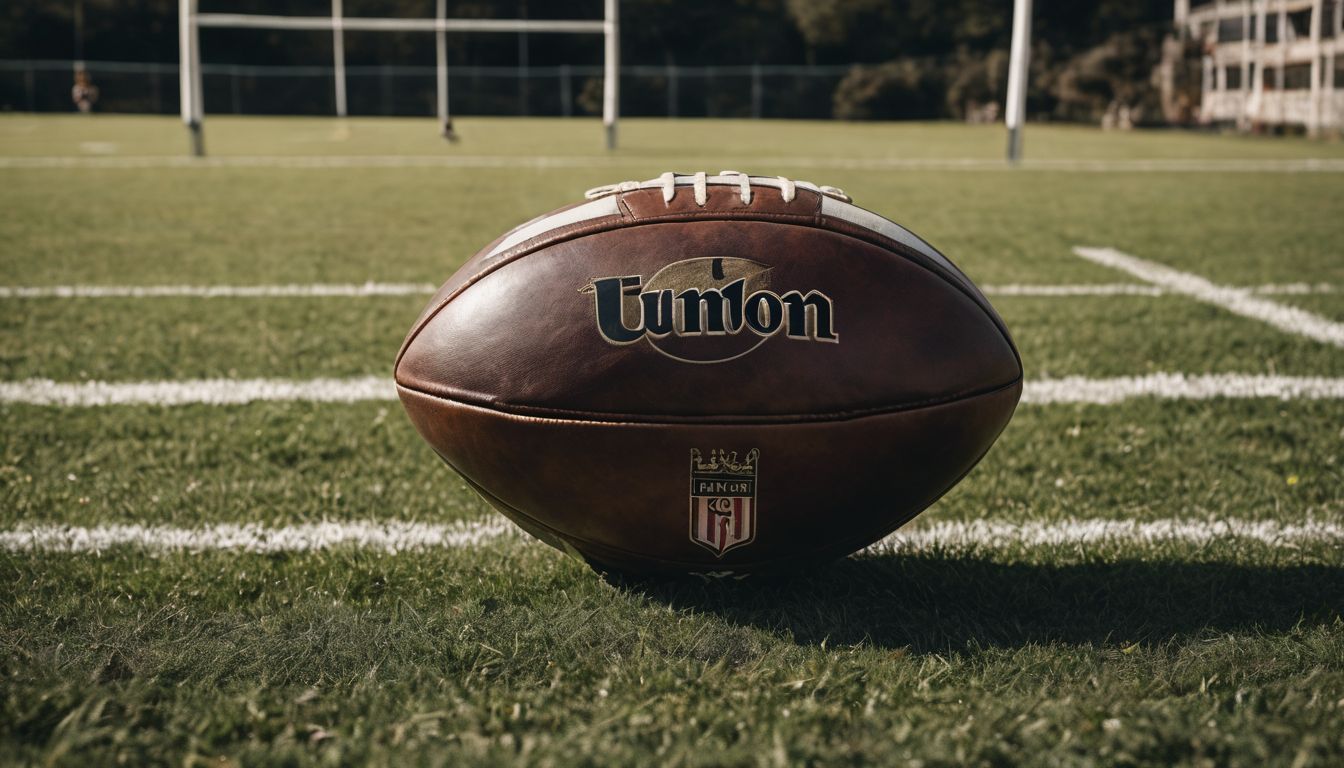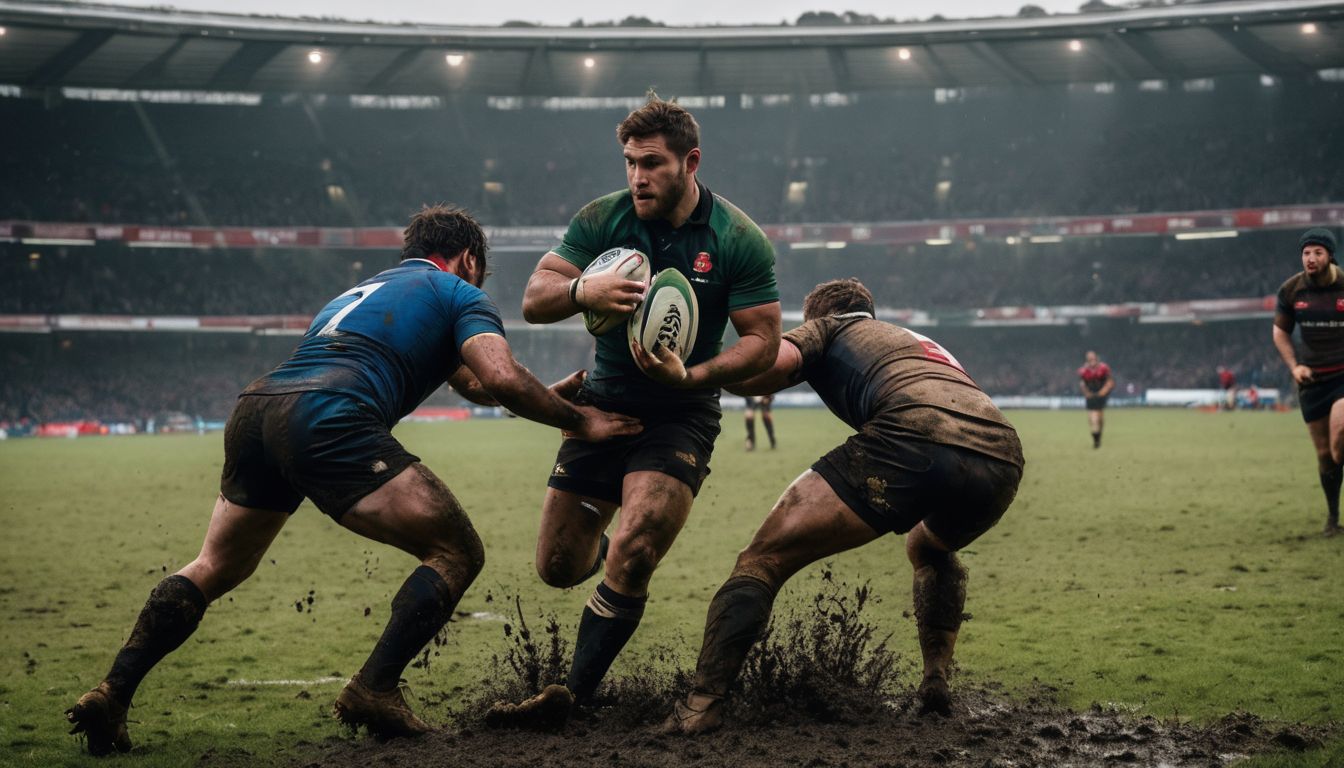Have you ever wondered what rugby players do after the final whistle blows? It’s not just showers and heading home; there’s a unique tradition known as the third half. Our article takes you into this heartwarming ritual, where once fierce competitors become friends over food and drinks.
Discover why this post-match celebration is as important as the game itself!
Key Takeaways
- The third half tradition in rugby stems from the amateur days of the game, encouraging players to socialise and share a drink with their opponents after a match.
- This post – match ritual embodies the core values of rugby such as respect, camaraderie, and sportsmanship, reinforcing community bonds across different teams.
- Italian Rugby legend Diego Dominguez regards the third half as fundamental to rugby culture, highlighting its role in promoting unity and lasting friendships within the sport.
- Across various cultures, this tradition takes on unique forms ranging from shared meals to formal ceremonies and even traditional dances or music performances.
- Women’s rugby embraces similar traditions for the third half, focusing on inclusivity and community building through post-match socialisation.
Origin of the Tradition
Digging into the roots of this post-match tradition, we discover that the third half dates back to the early days of rugby union. Before professional contracts and sponsorships changed the game in 1995, players would often spend time together after matches, embodying the amateur ethos of camaraderie and sportsmanship.
It was an era when sharing a pint with your opponent was as much a part of the game as scoring tries.
This convivial custom blossomed out of respect for one another and a collective passion for rugby. Legendary figures like Italian Rugby icon Diego Dominguez highlight it as not only customary but essential to what makes rugby unique among sports.
The third half’s enduring presence speaks volumes about its significance; fostering community bonds and encouraging mutual respect has always been at heart since teams first took to the field.
The Importance of the Third Half
The third half in rugby holds significant importance as it embodies the core values of rugby union and carries on the tradition from the amateur era. It serves as a platform for unity, socialisation, and post-match celebration among players and opponents.
Values of Rugby Union
Rugby union embodies the values of respect, camaraderie, and sportsmanship. These values are central to the sport and are reflected in the tradition of the third half. This post-match socialisation fosters a sense of community and mutual respect between opponents on the field.
It provides a platform for players to bond, share stories, and build lasting friendships beyond the competition on the field.
The tradition also encapsulates rugby’s emphasis on unity and inclusivity as it brings together all players from both teams in an informal setting. As Italian Rugby legend Diego Dominguez describes it, this ritual is one of the most characteristic traditions of rugby, emphasising its significance within the culture of rugby union.
Amateur Era Tradition
The tradition of the third half in rugby harks back to the amateur era, representing a time when post-match socialisation was integral to the sport. Before 1995, players from both teams would gather after the game for an informal exchange of drinks and food, fostering camaraderie and respect.
This tradition was more than just a casual get-together; it embodied the core values of rugby union – respect for opponents and sportsmanship. The ritual allowed players to come together in a relaxed atmosphere, sharing stories, traditional songs, and creating lasting friendships beyond the competition on the field.
Embracing this age-old custom has greatly influenced the spirit of unity in modern-day rugby, extending beyond just post-match rituals onto ongoing interactions between players off-field.
Unity and Socialisation
The third half in rugby fosters unity and socialisation among players from opposing teams. It provides an opportunity for everyone to come together, share food and drinks, and engage in informal conversations, strengthening the bonds within the rugby community.
This tradition embodies the core values of respect, camaraderie, and sportsmanship that are fundamental to the spirit of rugby. Italian Rugby legend Diego Dominguez describes it as one of the most characteristic traditions of the world of rugby, emphasising its significance in promoting a sense of mutual respect and community among players.
Players engage in post-match rituals such as sharing traditional songs, enjoying drinks, and partaking in food offerings during this informal gathering. The third half is not just a post-match tradition; it serves as a platform for players to build lasting friendships beyond the competition on the field.
The Ritual of the Third Half
Post-match celebrations, sharing a drink with opponents, and the informal setting of the third half are all part of this unique rugby tradition. To learn more about the diverse rituals and meanings associated with the third half in rugby, keep reading.
Post-Match Celebration
- Players gather after the game to share traditional songs, which adds to the informal and relaxed atmosphere of the post-match celebration.
- The sharing of food and beer among players promotes unity and bonding between opponents as part of the third half tradition.
- Post – match celebration involves engaging in informal socialisation where players bond through storytelling and laughter, creating a strong sense of camaraderie.
- The third half tradition allows for players to unwind after the game, offering an opportunity for them to relax and enjoy each other’s company in a more casual setting.
- The post – match celebration fosters a spirit of sportsmanship as players engage in friendly banter and interactions that go beyond the competitive nature of the game.
- This tradition is an integral aspect of rugby culture that contributes significantly to the overall experience and spirit of the sport.
- The post – match celebration provides an opportunity for players to reflect on their performance on the field while strengthening friendships with opponents through mutual respect and shared experiences.
- Players actively participate in sharing food and drinks as part of this tradition, embodying values such as generosity, hospitality, and inclusivity within rugby culture.
- The informal setting during post – match celebrations creates a space for players to build lasting connections beyond their roles as competitors on the rugby field.
- Post – match celebrations play a pivotal role in upholding the moral traditions of rugby by promoting unity, respect, and community building among players from different teams.
Involvement of Opponents
Opponents actively participate in the tradition of the third half by joining in post-match socialisation, where they share food and drinks with their rivals. This fosters a sense of camaraderie and mutual respect between the two teams, embodying the values of rugby that go beyond competition on the field.
The informal setting allows players to bond, share stories, and build lasting friendships, contributing to a positive atmosphere within the rugby community.
Moving forward, let’s delve into how this tradition varies across different cultures and its various meanings in diverse rugby communities.
Informal Setting and Alcohol Consumption
After the post-match celebration and involvement of opponents, the third half continues in an informal setting often with alcohol consumption. This tradition embodies a relaxed atmosphere where players from both teams can unwind, share stories, and build lasting friendships over drinks and food.
The informal setting encourages camaraderie beyond competition on the field, creating a space for shared laughter and bonding. Italian Rugby legend Diego Dominguez describes this as one of the most cherished traditions of rugby, emphasising its role in fostering unity and mutual respect among players.
The inclusion of alcohol in this casual get-together is symbolic of the sport’s social aspect and emphasises conviviality rather than excessive drinking. It serves as a way to further relax after the intense game while reinforcing the sense of community that is central to rugby culture.
Diversity in Third Half Traditions
Across different cultures, the tradition of the third half varies, with each community adding its unique touch. The meaning of alcohol in the third half changes from one culture to another and has had a significant impact on women’s rugby.
Plurality Across Different Cultures
Various cultures around the world embrace their own unique traditions for the third half in rugby. In New Zealand, it is common to share a hearty meal and engage in friendly banter over some brews after the game.
On the other hand, in Japan, players often participate in formal ceremonies and exchange gifts as a way of showing respect and gratitude towards one another. Meanwhile, South African rugby teams celebrate with braais (barbecues) where everyone gets together to enjoy grilled food and socialise.
Moreover, in Argentina, post-match celebrations may involve traditional dances such as tango or folk music performances accompanied by local delicacies and beverages.
Women’s rugby also showcases its own distinct third half rituals across different cultures. In some countries like England and Australia, female players partake in similar post-match socialisation practices to their male counterparts with an emphasis on camaraderie and community building.
Various Meaning of Alcohol in the Third Half
Alcohol in the third half of rugby holds different meanings across cultures. For some, it symbolises camaraderie and mutual respect between opponents. It serves as a gesture of hospitality, offering a drink to the opposing team signifies goodwill and sportsmanship.
In other contexts, alcohol during the third half represents celebration and relaxation after an intense match. The informal setting allows players to bond over shared experiences while enjoying a drink together.
In women’s rugby, the significance of alcohol in the third half differs from men’s rugby. Rather than focusing on camaraderie through drinking, it emphasises inclusivity and socialisation.
Impact on Women’s Rugby
The tradition of the third half in rugby has had a significant impact on women’s rugby, fostering a sense of community and camaraderie. Women’s rugby teams partake in post-match socialisation, offering drinks and food to their opponents as a symbol of respect and sportsmanship.
This tradition provides an opportunity for female players to bond, share stories, and build lasting friendships beyond the competition on the field.
Furthermore, the informal setting of the third half allows women’s rugby teams to create a more relaxed atmosphere where they can engage with their opponents in a spirit of unity and mutual respect.
Embracing this tradition has become an integral part of women’s rugby culture, enriching the overall experience and spirit of the game while reinforcing important values central to the sport.
Conclusion: Embracing the Tradition of the Third Half in Rugby
Embracing the tradition of the third half in rugby allows players to come together, bond, and share stories beyond the competition on the field. It embodies values of respect, camaraderie, and sportsmanship central to the sport.
Post-match socialisation fosters a sense of community and mutual respect between opponents. Players engage in informal socialisation with traditional songs, drinking, and food after showering post-game.
The third half contributes to the overall experience and spirit of rugby culture.
FAQs
1. What does the ‘third half’ refer to in rugby?
The ‘third half’ is a post-match tradition where players and fans socialise, often involving traditional rugby songs, food traditions, and sometimes alcohol consumption.
2. Why is the third half important in rugby culture?
This tradition strengthens rugby values such as camaraderie and respect through post-match rituals that bring teams together irrespective of the game’s outcome.
3. Are women’s rugby rituals included in the third half?
Yes, women’s rugby rituals are part of this tradition; they participate fully in post-match socialisation reflecting shared values across men’s and women’s rugby.
4. Does every level of play observe Rugby’s third-half custom?
From local club matches to events as large as the Rugby World Cup, teams celebrate with these post-match traditions which form a core element of the sport’s character.
5. Is there more to the third-half than just drinking culture?
Absolutely! While some might associate it with drinking, it equally emphasises sharing meals and forming bonds over shared experiences that go beyond alcohol consumption.
















